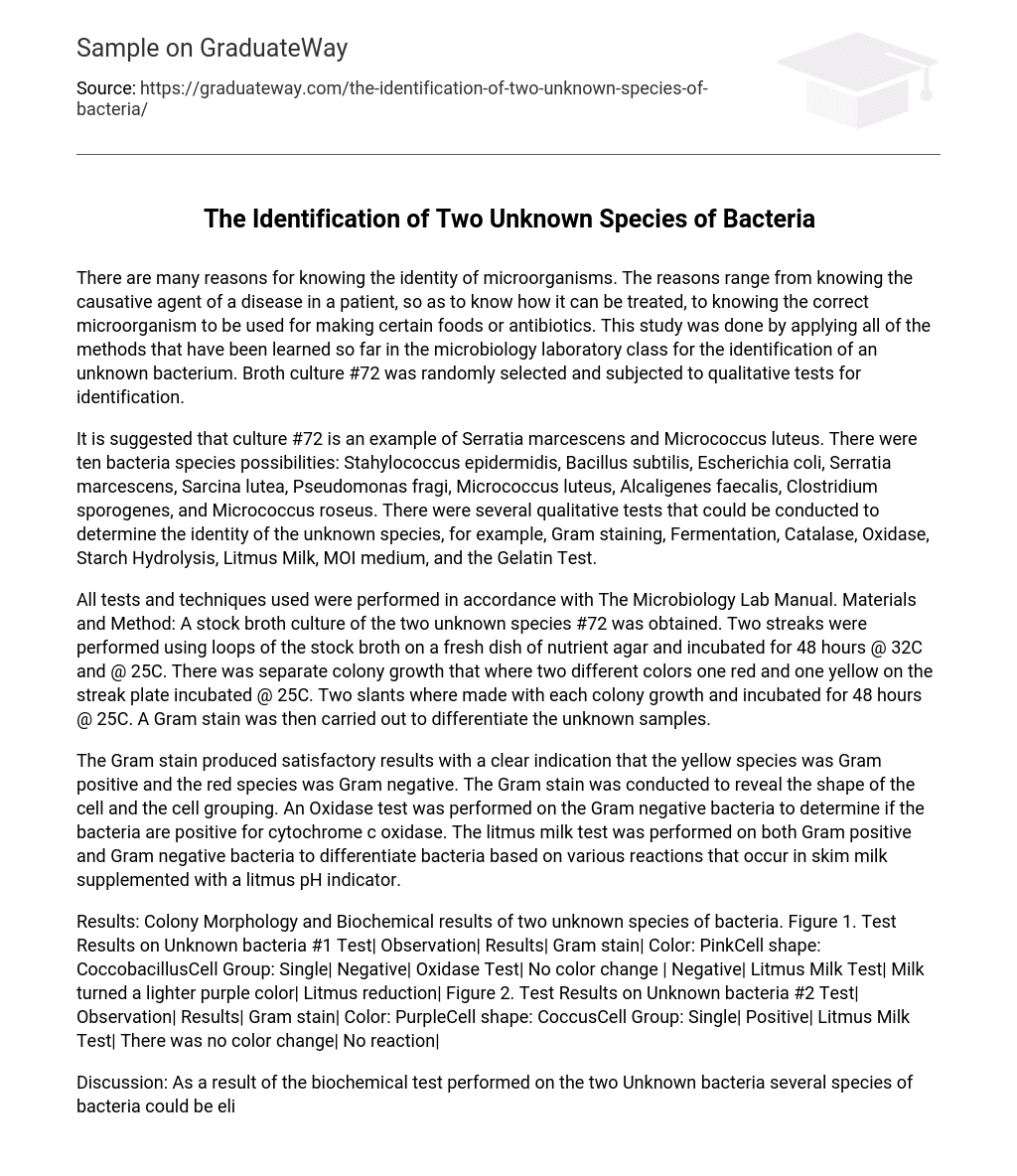There are many reasons for knowing the identity of microorganisms. The reasons range from knowing the causative agent of a disease in a patient, so as to know how it can be treated, to knowing the correct microorganism to be used for making certain foods or antibiotics. This study was done by applying all of the methods that have been learned so far in the microbiology laboratory class for the identification of an unknown bacterium. Broth culture #72 was randomly selected and subjected to qualitative tests for identification.
It is suggested that culture #72 is an example of Serratia marcescens and Micrococcus luteus. There were ten bacteria species possibilities: Stahylococcus epidermidis, Bacillus subtilis, Escherichia coli, Serratia marcescens, Sarcina lutea, Pseudomonas fragi, Micrococcus luteus, Alcaligenes faecalis, Clostridium sporogenes, and Micrococcus roseus. There were several qualitative tests that could be conducted to determine the identity of the unknown species, for example, Gram staining, Fermentation, Catalase, Oxidase, Starch Hydrolysis, Litmus Milk, MOI medium, and the Gelatin Test.
All tests and techniques used were performed in accordance with The Microbiology Lab Manual. Materials and Method: A stock broth culture of the two unknown species #72 was obtained. Two streaks were performed using loops of the stock broth on a fresh dish of nutrient agar and incubated for 48 hours @ 32C and @ 25C. There was separate colony growth that where two different colors one red and one yellow on the streak plate incubated @ 25C. Two slants where made with each colony growth and incubated for 48 hours @ 25C. A Gram stain was then carried out to differentiate the unknown samples.
The Gram stain produced satisfactory results with a clear indication that the yellow species was Gram positive and the red species was Gram negative. The Gram stain was conducted to reveal the shape of the cell and the cell grouping. An Oxidase test was performed on the Gram negative bacteria to determine if the bacteria are positive for cytochrome c oxidase. The litmus milk test was performed on both Gram positive and Gram negative bacteria to differentiate bacteria based on various reactions that occur in skim milk supplemented with a litmus pH indicator.
Results: Colony Morphology and Biochemical results of two unknown species of bacteria. Figure 1. Test Results on Unknown bacteria #1 Test| Observation| Results| Gram stain| Color: PinkCell shape: CoccobacillusCell Group: Single| Negative| Oxidase Test| No color change | Negative| Litmus Milk Test| Milk turned a lighter purple color| Litmus reduction| Figure 2. Test Results on Unknown bacteria #2 Test| Observation| Results| Gram stain| Color: PurpleCell shape: CoccusCell Group: Single| Positive| Litmus Milk Test| There was no color change| No reaction|
Discussion: As a result of the biochemical test performed on the two Unknown bacteria several species of bacteria could be eliminated as possible suspects. For unknown bacteria #1, the Gram negative results narrowed the possibilities down to E. coli, P. fragi, A. facillis and S. marcescens. The negative Oxidase test results eliminated P. fragi, A. facillis, leaving only two bacteria E. coli and S. marcescens as possibilities. The Litmus milk test resulted in Litmus reduction ruling out E. coli and verifying the unknown #1 bacteria to be S. arcescens. S. marcescens is commonly found growing in bathrooms where it manifests as a pink discoloration and slimy film feeding off phosphorus-containing materials or fatty substances such as soap and shampoo residue. Once established, complete eradication of the organism is often difficult, but can be accomplished by application of a bleach-based disinfectant. Rinsing and drying surfaces after use can also prevent the establishment of the bacteria by removing its food source and making the environment less hospitable (2).
For unknown bacteria #2 the Gram Positive results narrowed the possibilities down to. S. epidermidis, B subtilis, S. luteus, M. luteus, C. sporogenes, and M. roseus. The Litmus milk test resulted in no change therefore ruling out all bacteria except for M. luteus and M. roseus. It was determined that M. roseus grows red 25C and M. luteus grows yellow at 25C therefore verifying the unknown #2 bacteria to be M. luteus. M. luteus is found in soil, dust, water and air, and as part of the normal flora of the mammalian skin.
The bacterium also colonizes the human mouth, mucosae, oropharynx and upper respiratory tract. Considered a contaminant in sick patients. M. luteus is resistant to reduced water potential and can tolerate drying and high salt concentrations (2). Conclusion: The Identification of two unknown species of bacteria in tube #72 are Serratia marcescens and Micrococcus luteus
References:
1. Sigmon, J. Bio 225: Microbiology Lab Manual, York Technical College, 2004, pp. 1-58 2. http://microbewiki. kenyon. edu/index. php/MicrobeWiki





